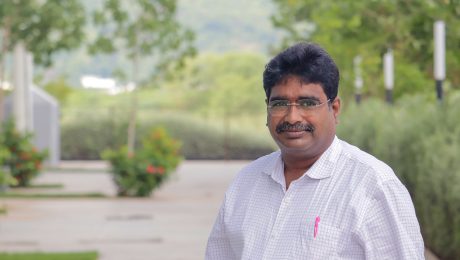STIP- 2020: “Impartial inclusion will make India global scientific superpower”
“India is moving towards ‘technological self-reliance’ and will emerge as one of the ‘Top 3 scientific superpowers’ through Science, Technology and Innovation Policy (STIP) 2020: A Transformative Science and Technology Agenda,” said Dr Sandeep Verma, Secretary of Science and Engineering Research Board (SERB), in the thirteenth edition of University Distinguished Lecture Series conducted by SRM University-AP, Andhra Pradesh on October 30, 2021.
The objectives of the Distinguished Lecture were enumerated by the Pro-Vice-Chancellor, Prof D Narayana Rao. He further said that the STIP: 2020 will greatly enhance the scientific contributions of Universities, Institutions and National Laboratories. He said that Universities and Institutions are hubs for innovations.
Dr Verma, a recipient of one of the highest Indian awards in the field of Science, the Shanti Swarup Bhatnagar Prize, is known for his contributions towards experimental medicine by working in the areas of bio-chemical interface. Prof Verma felt that the vision behind STIP: 2020 can only be executed through innovative, collaborative, and open science research that is best implemented in Universities and Educational Institutions like SRM University-AP.
Dr Verma elucidated that the primary idea behind STIP: 2020 is Inclusivity. STIP: 2020 will require an uninhibited and indiscriminate free flow of scientific and innovative ideas between all the people with a scientific interest from the Indian diaspora and from rural India, from all genders, from all age groups ignoring any disability physical or otherwise. “We can’t afford to leave anyone behind”, Dr Verma said referring to India’s quest to become a scientific and technological superpower. Prof Sandeep Verma said that the gross spending of the country on R & D increased 3 times during the last 8 years.
Appreciating the efforts made by SRM University-AP, Dr Verma emphasised the need to have the researchers coming out in the open, solving real-life problems and making every individual Indian life better. “It is our Scientific Social Responsibility to conduct such open forums for scientific communication and understanding,” he said, “As India prepares to grow towards technological self-reliance and indigenisation with the support of various schemes under Atmanirbhar Bharat and develop an ecosystem worthy of global benchmark, STIP: 2020 comes as a landmark innovation policy at this crucial juncture.”
Dr Verma ended his talk with the hopeful note that other Universities would follow the example of SRM University-AP and make such conscientious efforts towards innovation to make lives better. The lecture was attended by Dr S Chandrasekhar, Director, CSIR-IICT and over 2300 members from several premier institutions like IITs, NITs, IISERs, Universities and Institutions, CSIR, DST, DBT, DRDO, DAE, ISRO, NARL, MoES and several others from different parts of the country.
Prof V S Rao, Vice-Chancellor and Prof D Narayana Rao, Pro-Vice-Chancellor felicitated Prof Sandeep Verma and presented him with a memento.
- Published in News, Research News
High bars of predecessors for high marches of successors
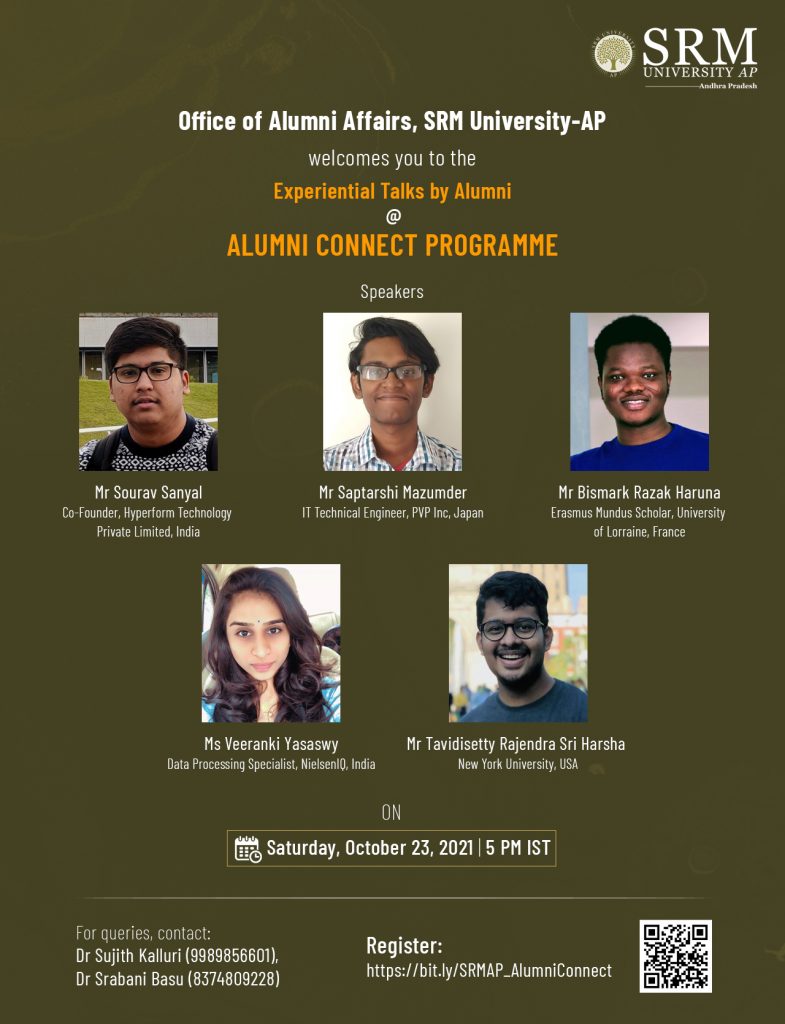 We bid adieu to the maiden batch with interesting placements and higher education opportunities in hand. Their farewell was as glorious as it was tearful. On October 23, 2021, SRM University-AP welcomed them back with the intention to aid the current students. In a colourful online ceremony, President Dr P Sathyanarayanan inaugurated the Alumni Connect Programme to help our students stay connected, even after graduation.
We bid adieu to the maiden batch with interesting placements and higher education opportunities in hand. Their farewell was as glorious as it was tearful. On October 23, 2021, SRM University-AP welcomed them back with the intention to aid the current students. In a colourful online ceremony, President Dr P Sathyanarayanan inaugurated the Alumni Connect Programme to help our students stay connected, even after graduation.
In his inaugural speech, Dr P Sathyanarayanan congratulated the graduate students for the rigorous years of studies and the many laurels that they have brought to their alma mater. He further expressed his beliefs that this kind of networking programme will bring the students closer and skillfully aid the existing students in their search for the best jobs, higher studies and other opportunities. “The founding batch has set the bar so high that the following batches will need to strive really hard to make their mark,” asserted Dr Sathyanarayan.
The event progressed with messages from Prof V S Rao, Vice-Chancellor, SRM University-AP and Prof D Narayana Rao, Pro-Vice-Chancellor, SRM University-AP. The eminent dignitaries launched the Alumni Yearbook-2021.
The event sprang to life with the jovial conversations between the alumni and the current students. The current students shared their fears and anxiety with their seniors, while our alumni shared their journey.
Listening to the alumni helped the current students be more confident and focused. The insights shared by the seniors helped the juniors plan their the academic and career trajectories more adequately.
The alumni also reminisced about their time at the University. They guided the current students on making the best use of all the state-of-the-art facilities that the University offers. In addition to that, they taught their juniors about managing academic studies and other activities without compromising with all the fun of college life.
The vigorous event came to an end with the facilitation ceremony by Ms Revathi B, Assistant Director, Student Affairs. Dr Sujith Kalluri, Assistant Director, Alumni Affairs, offered a concluding speech to mark the closing of the event.
- Published in News
Dr Hemantha Kumar Kalluri
- Published in CSE Faculty, Faculty, SEAS
Fully automated quality control of rigid and affine registrations of T1w and T2w MRI in Big Data using Machine Learning
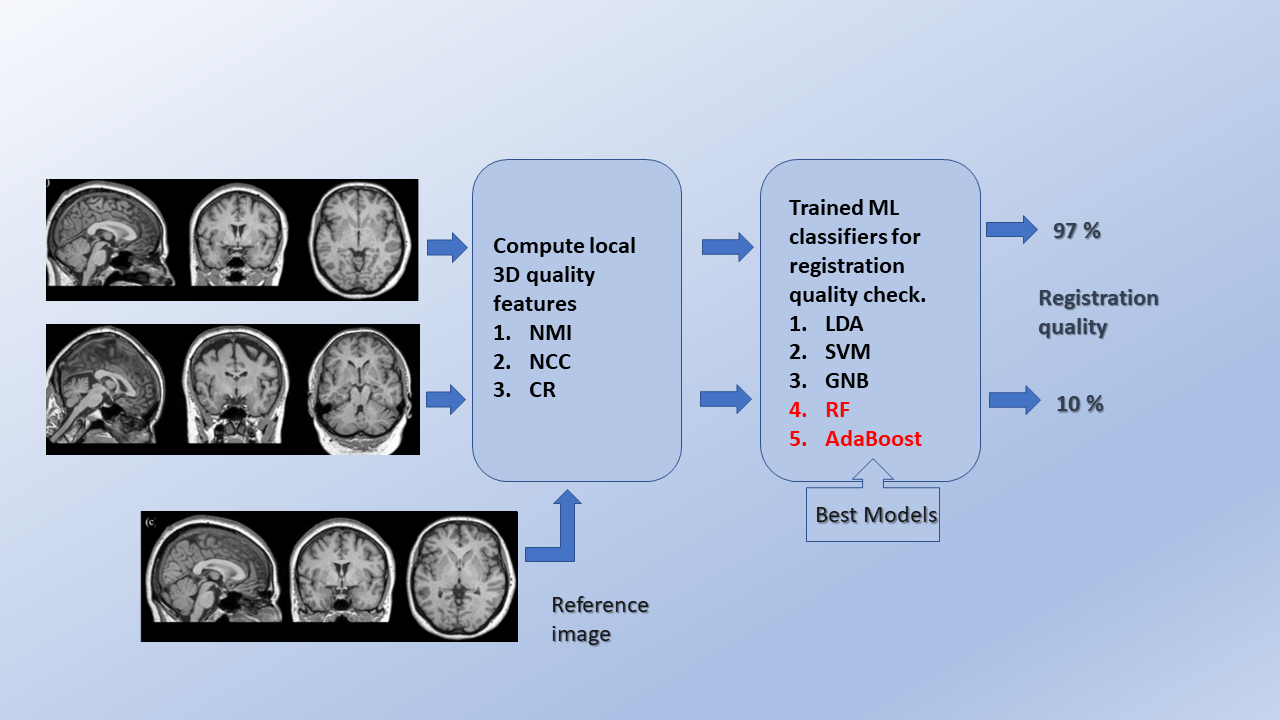 “Research is seeing what everybody else has seen and thinking what nobody else has thought.”
“Research is seeing what everybody else has seen and thinking what nobody else has thought.”
– Albert Szent-Györgyi
“Fully Automated Quality Control of Rigid and Affine Registrations of T1w and T2w MRI in Big Data using Machine Learning” is the latest research paper published by Dr Sudhakar Tummala, Assistant Professor, Electronics and Communication Engineering, SRM University-AP in ‘Computers in Biology and Medicine Journal’ having an Impact Factor of 4.6.
Abstract of the paper:
Background: Magnetic resonance imaging (MRI)-based morphometry and relaxometry are proven methods for the structural assessment of the human brain in several neurological disorders. These procedures are generally based on T1-weighted (T1w) and/or T2-weighted (T2w) MRI scans, and rigid and affine registrations to a standard template(s) are essential steps in such studies. Therefore, a fully automatic quality control (QC) of these registrations is necessary for big data scenarios to ensure that they are suitable for subsequent processing.
Method: A supervised machine learning (ML) framework is proposed by computing similarity metrics such as normalized cross-correlation, normalized mutual information, and correlation ratio locally. We have used these as candidate features for cross-validation and testing of different ML classifiers. For 5-fold repeated stratified grid search cross-validation, 400 correctly aligned, 2000 randomly generated misaligned images were used from the human connectome project young adult (HCP-YA) dataset. To test the cross-validated models, the datasets from autism brain imaging data exchange (ABIDE I) and information eXtraction from images (IXI) were used.
Results: The ensemble classifiers, random forest, and AdaBoost yielded the best performance with F1 scores, balanced accuracies, and Matthews correlation coefficients in the range of 0.95-1.00 during cross-validation. The predictive accuracies reached 0.99 on Test set #1 (ABIDE I), 0.99 without and 0.96 with noise on Test set #2 (IXI, stratified w.r.t scanner vendor and field strength).
Conclusions: The cross-validated and tested ML models could be used for QC of both T1w and T2w rigid and affine registrations in large-scale MRI studies.
Medical imaging is basically a method to see inside the body non-invasively. Magnetic resonance imaging (MRI) is one of the medical imaging modalities to see inside the body. MRI works on the principles of nuclear magnetic resonance. T1-weighted (T1w) and T2-weighted (T2w) MRI can enable us to see the brain without opening the skull and to monitor brain structural changes that occur in several medical and neurological conditions. It is important to monitor these structural changes over time to understand the disease progression. For example, in Alzheimer’s disease, it is important to monitor the hippocampus (memory storage centre) Recently, due to the advances in computational power such as high-performance GPUs and the availability of publicly accessible big data MRI, scientists around the world now conducting big data research studies. In group-based big data studies, for fair comparison of the brain between healthy and diseased individuals, it is necessary that the brain MRI images are registered to a common coordinate system. Therefore, quality control (QC) of these registrations is necessary to ensure that they are suitable for further processing. Further, in big data studies that involve several thousands of images, manual QC is not feasible and hence there is a need for a fully automated QC mechanism at the pre-processing stage. Checking the quality of rigid and affine registrations is one such task.
The research group implemented a fully automated QC mechanism based on computing several quality metrics local to the image and trained several machine learning classifiers based on these locally computed quality measures. The trained classifiers include linear discriminant analysis, support vector machine, Gaussian naïve Bayes, random forest and adaptive boosting. The developed ML models generalize well to detect misaligned registrations across different MRI scanner vendors and field strengths and even under noisy image situations. Therefore, the classifiers could be employed in big data studies for fully automated QC of registrations, especially T1w and T2w MRI.
Big data MRI studies are generally conducted using a large number of subjects. The conclusions drawn based on big data analysis are more reliable and help to understand the disease mechanics better. The developed method can help to reduce the manual labour for various QC mechanisms required during the pre-processing stage.
This work is done in collaboration with
a. Prof Erik B Dam, Machine Learning Group, University of Copenhagen, Copenhagen, Denmark.
b. Prof Niels K Focke, Clinic for neurology, University Medical Centre, Göttingen, Germany.
In future, the idea is to implement the QC framework using sparse autoencoders in an unsupervised manner and also using Siamese neural networks via deep representation learning.
- Published in Departmental News, ECE NEWS, News, Research News
Navier stokes equations: A million dollar open problem
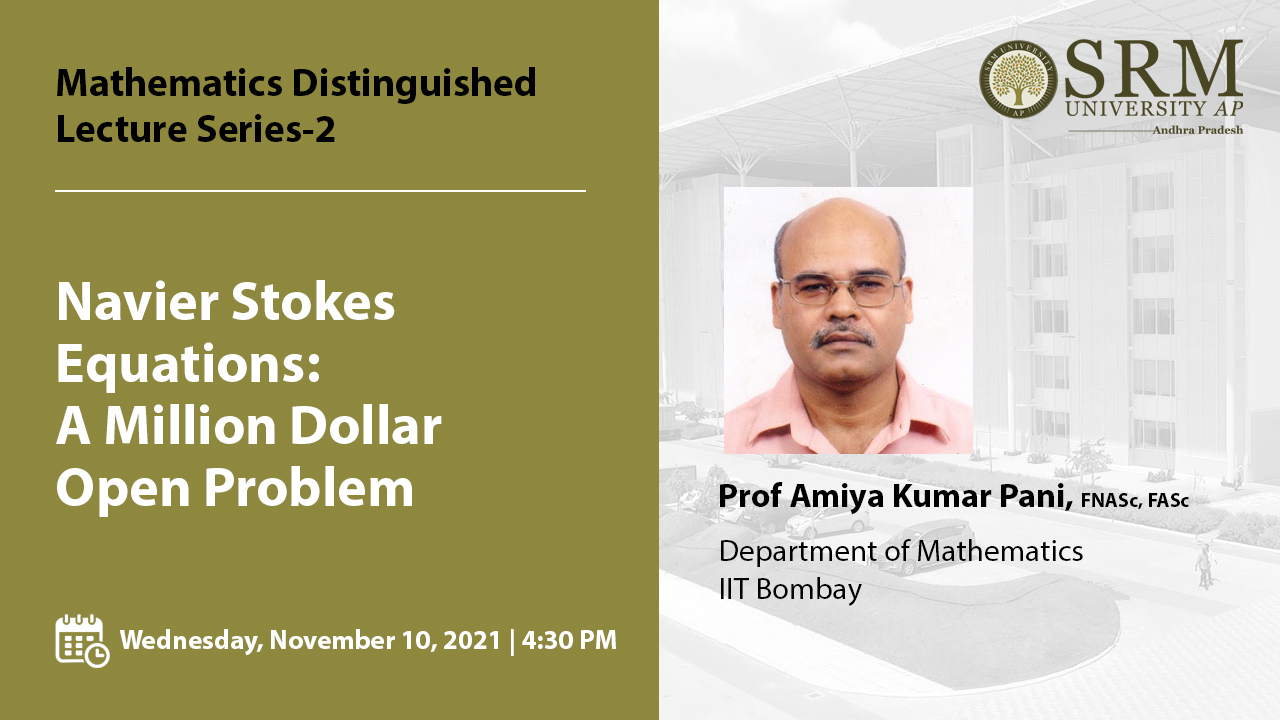 The second lecture in the Distinguished Lecture Series organised by the Department of Mathematics at SRM University-AP will be held on November 10, 2021, at 4.30 pm. Prof Amiya Kumar Pani from the Department of Mathematics, IIT Bombay, will elucidate the lecture on the topic “Navier Stokes Equations: A Million Dollar Open Problem”.
The second lecture in the Distinguished Lecture Series organised by the Department of Mathematics at SRM University-AP will be held on November 10, 2021, at 4.30 pm. Prof Amiya Kumar Pani from the Department of Mathematics, IIT Bombay, will elucidate the lecture on the topic “Navier Stokes Equations: A Million Dollar Open Problem”.
On August 8, 1900, David Hilbert delivered his famous lecture about 23 open mathematical problems at the second International Congress of Mathematicians in Paris. This influenced the decision of a recently formed Clay Mathematical Institute (CMI) to announce the seven Millennium Prize Problems in the CMI Millennium Meeting held on May 24, 2000. One such problem is the theme of the present talk. Now it is widely accepted that the motion of an incompressible viscous fluid with moderate velocity is described by the Navier-Stokes Equations. Although these equations were written down in the 19th century, the existing mathematical results are not adequate to unfold the secrets hidden in the Navier-Stokes equations.
In this talk, Prof Amiya shall concentrate on a brief description of this problem, mathematical model, a quick look at history, what is known at this point, some important approaches and what is possibly needed. Finally, he will conclude the talk with a note on the present state of Indian applied mathematics and whether we are ready to contribute towards this millennium problem.
About the Speaker:
Prof Amiya K Pani is Professor at IIT, Bombay. He is well known for his research work in the area of numerical approximations of partial differential equations. His expertise includes construction, stability, and convergence analysis of finite element methods, finite difference schemes, orthogonal spline collocation methods for free boundary problems, partial integrodifferential equations, coupled equations in Oil Reservoir Studies, evolutionary variational inequalities, and scientific computations for industrial applications. Professor Pani is a fellow of the Indian Academy of Sciences and National Academy of Sciences, India. He was awarded the Best Young Mathematician for his outstanding contributions to Numerical Analysis, Partial Differential Equations, and Industrial Mathematics by the Indian Society for Industrial and Applied Mathematics (ISIAM).
Tune in to this intriguing lecture on Navier stokes equations on November 10, 2021, at 4.30 pm.
- Published in Departmental Events, Events, Invited Talks, Math Events
Why India needs innovation and leadership?
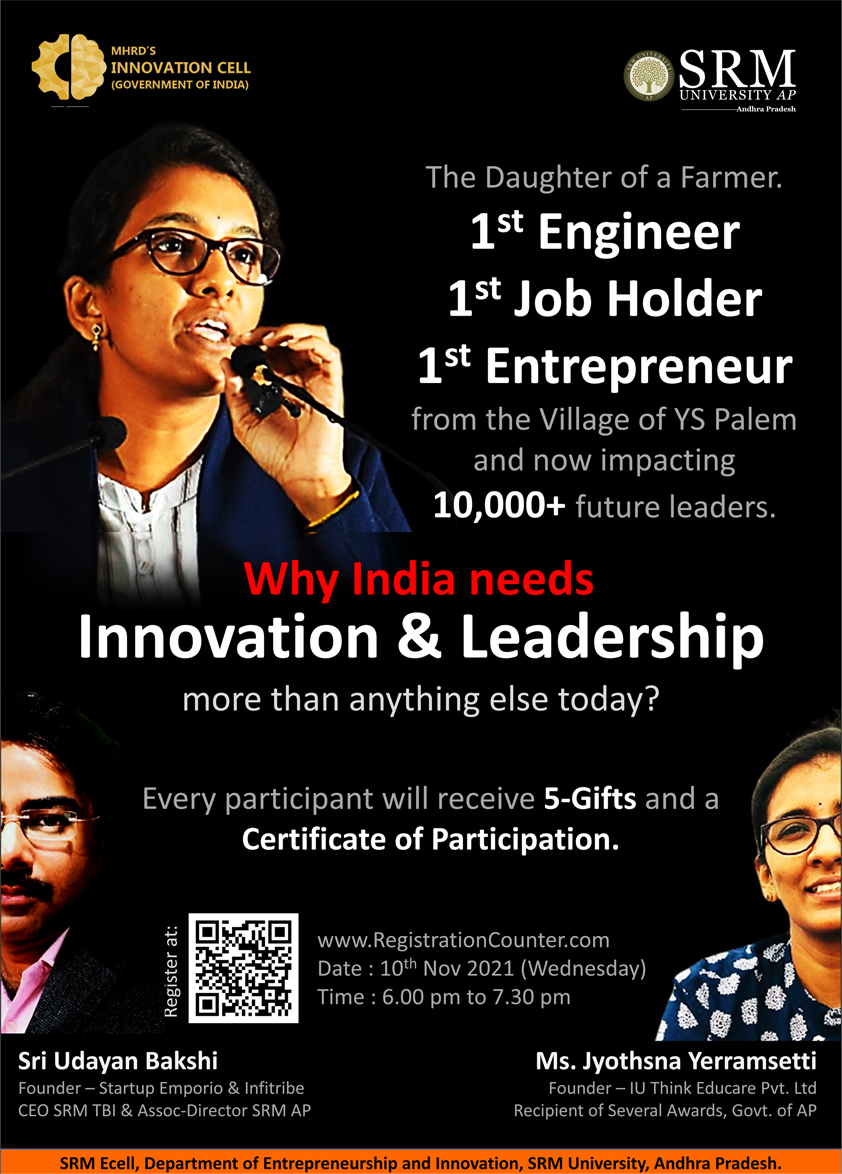 To nurture and cultivate innovation, there are no best-practice solutions. The structures and processes that many leaders employ instinctively to foster it are vital but insufficient. The Department of Entrepreneurship and Innovation at SRM University-AP is organising an influential session by Jyothsna Yerramsetti, CEO & Co-Founder- IUThink, on November 10, 2021, at 6.00 pm to promote and integrate innovative leadership among students. All participants will be given various gifts and certificates and participation.
To nurture and cultivate innovation, there are no best-practice solutions. The structures and processes that many leaders employ instinctively to foster it are vital but insufficient. The Department of Entrepreneurship and Innovation at SRM University-AP is organising an influential session by Jyothsna Yerramsetti, CEO & Co-Founder- IUThink, on November 10, 2021, at 6.00 pm to promote and integrate innovative leadership among students. All participants will be given various gifts and certificates and participation.
IUThink is an organisation with a vision to provide a platform for grassroots, student and rural Innovators. It focuses on connecting students, innovators, startups and entrepreneurs to mentors, investors and creates opportunities to network with successful entrepreneurs. IUThink organises Startup/Innovation Summits where innovators and startups get a chance to exhibit their ideas and also provides entrepreneurial functionality support for college incubations. The main objective of IUThink is to create a proper Start-up Ecosystem to connect all the startups/entrepreneurs. In 2019-2021 it organised 3 innovation summits and connected 5000+ students/innovators/startups/ entrepreneurs and created a huge impact by organising awareness programmes.
About the Speaker:
Jyothsna Yerramsetti, CEO & Co-Founder- IUThink completed Graduation in Information Technology 2013. She worked as a software engineer for 5 years in one of the big MNCs at Hyderabad and established her startup company “IUThink” in 2018 August along with Cofounder Divya Kalikota. IUThink encourages startups, entrepreneurs and innovators. She is a recipient of the “Outstanding Educator” by South India Women Achievers Award (SIWAA) in Chennai and was recognised as “Young Leader” by Niti Manthan, New Delhi.
Unlock the innovator inside you with SRM E-Cell, grabbing gifts and certificates! Stay tuned to this inspiring session on November 10, 2021, at 6.00 pm.
- Published in Events, IDEA Events, Invited Talks
Dr VK Saraswat inaugurated Centres of Excellence to promote translational research
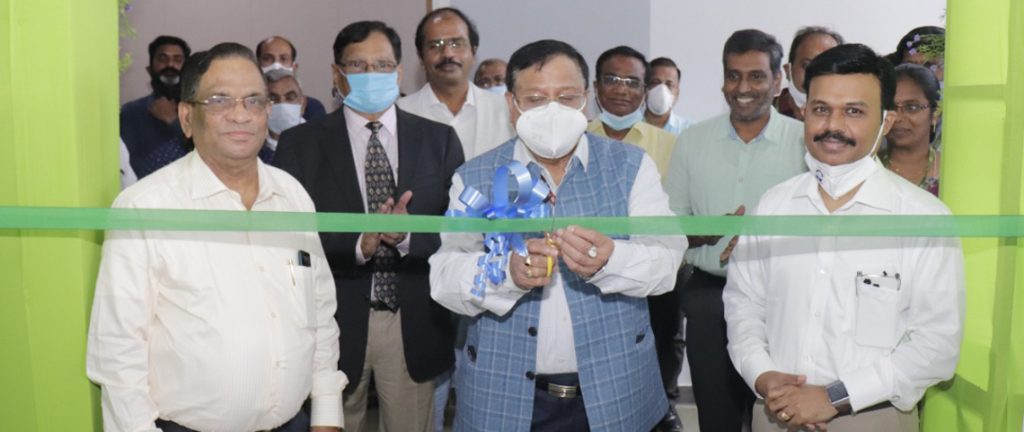 SRM University-AP organised its University Research Advisory Council Meeting on Monday, November 08, 2021. Dr V K Saraswat, Hon’ble Member, NITI AAYOG, chaired the meeting as the Chairman of the Council. Dr P Sathyanarayanan, President, SRM University-AP, Prof VS Rao, Vice-Chancellor, SRM University-AP, Prof D Narayana Rao, Pro-Vice-Chancellor, SRM University-AP, Dr Vinayak Kalluri, Registrar-in-Charge were among other dignitaries.
SRM University-AP organised its University Research Advisory Council Meeting on Monday, November 08, 2021. Dr V K Saraswat, Hon’ble Member, NITI AAYOG, chaired the meeting as the Chairman of the Council. Dr P Sathyanarayanan, President, SRM University-AP, Prof VS Rao, Vice-Chancellor, SRM University-AP, Prof D Narayana Rao, Pro-Vice-Chancellor, SRM University-AP, Dr Vinayak Kalluri, Registrar-in-Charge were among other dignitaries.
In his keynote speech, Dr V K Saraswat congratulated SRM University-AP for their remarkable progress as a university in the past two years. As a nascent university, SRMAP has already made its reputation as a progressive research university of the new era with numerous laurels to its credit. “India is going through a pedagogical shift in terms of policy and implementation. National Education Policy-2020 has sagaciously replaced the age-old redundant policy of 1968. It feels wonderful to note that SRM University-AP is already following NEP-2020 and its recommendations. NEP-2020 has provided extraordinary possibilities and opportunities to make the best use of human and natural resources in terms of education and research. NEP-2020 focuses on making India self-reliant as a nation. Hence NEP-2020 is to create job providers, no more job seekers”, said Dr Saraswat.
The suggestions and recommendations of NEP-2020 are curated to facilitate innovation and brilliance. The universities and educational institutions that are the cores of knowledge creation and dissemination are trusted with this responsibility of creating the leaders of tomorrow. In the twenty-first century, the focus should be on translational research of multidisciplinary nature. Industry-Academic relationships are needs of the hour. Dr Saraswat further proposed to develop Value Addition Centre in SRM University-AP to promote translational research. The centre will be strengthening the relationship between Industry and Academia to work on product engineering to deliver market relevant products. “Upscaling and upskilling are substantial in product engineering. We should further be focused on linking our curriculum to India’s glorious heritage. Our ancestors made tremendous progress in science, medicine, astrology, astronomy and other branches that the outside world knows very little about. It is now time to remember them and learn from them,” opined Dr Saraswat.
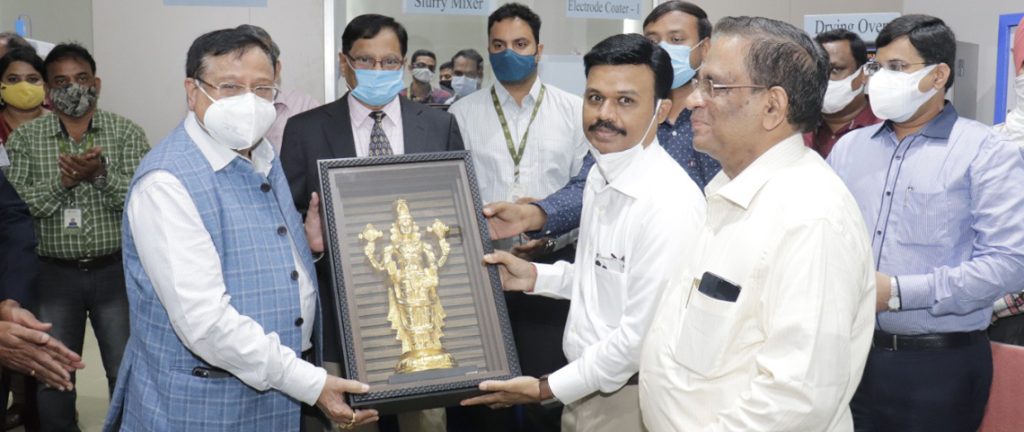 For any country that aspires to be among the best globally, knowledge generation should be given importance. For a country like India, with a population of 130 crores, unemployability is a curse. Following the recommendations of NEP-2020, focus should be put on Vocational Courses. It is vital that the students of this generation are aware of the science of engineering rather than science and engineering. Science of Engineering leads to the generation of knowledge, research with meaningful publications and recognition. Dr Saraswat further pointed out that liberal arts are an essential factor for holistic personality development in students.
For any country that aspires to be among the best globally, knowledge generation should be given importance. For a country like India, with a population of 130 crores, unemployability is a curse. Following the recommendations of NEP-2020, focus should be put on Vocational Courses. It is vital that the students of this generation are aware of the science of engineering rather than science and engineering. Science of Engineering leads to the generation of knowledge, research with meaningful publications and recognition. Dr Saraswat further pointed out that liberal arts are an essential factor for holistic personality development in students.
India has an ambitious plan to make the country carbon neutral by the year 2070. Thus, encouragement is given on environment-friendly research. Thrust is given on the green environment, energy efficiency, alternate and unconventional sources of energy, use of renewable resources and recycle of industrial waste among others. Research should be cost-effective and environment friendly. The focus should be on reducing the carbon footprint in nature with proper planning on the use-storage and distribution of hydrogen in nature. India produces many academicians, scientists and engineers every year, but today India is more about theoretical research. It is now time not only to write papers but also to produce designs that are market relevant. SRMAP should take the initiative in this regard to deliver India able designer-engineers.
Dr V K Saraswat inaugurated two Centres of Excellence that SRM University-AP has recently established to promote translational research. SRM Amara Raja Centre for Energy Storage Devices is set up, in collaboration with Amara Raja Batteries Limited- Tirupati, with a commitment to application-oriented research in the renewable energy and e-mobility. Centre for pioneering studies in Gold & Silver will be working on flagship project with Titan Company Ltd (TANISHQ) to develop novel gold alloy for contemporary jewellery design. The centre also aims to work on projects in collaboration with Waman Hari Pethe & Sons, Mumbai and other jewellery manufacturers across India to produce high strength 22 Karat gold and develop tarnish free silver alloys.
Dr P Sathyanarayanan, President, SRM University-AP, shared his vision to make SRM University-AP as a new-age world-class research university. He agreed with Dr Saraswat and asserted that the management of SRMAP is ready to provide every help needed. “SRMAP encourages deep industry engagements, entrepreneurship along with technological education and advancement. To provide holistic education to students, SRMAP provides a strong emphasis on liberal arts,” said Dr Sathyanarayanan. Prof VS Rao, Vice-Chancellor, SRM University-AP, further elaborated on the extensive plan that SRMAP has to build a world-class university in the heart of Andhra Pradesh. The university has collaborative lineage with reputed names in education to provide best education to the students.
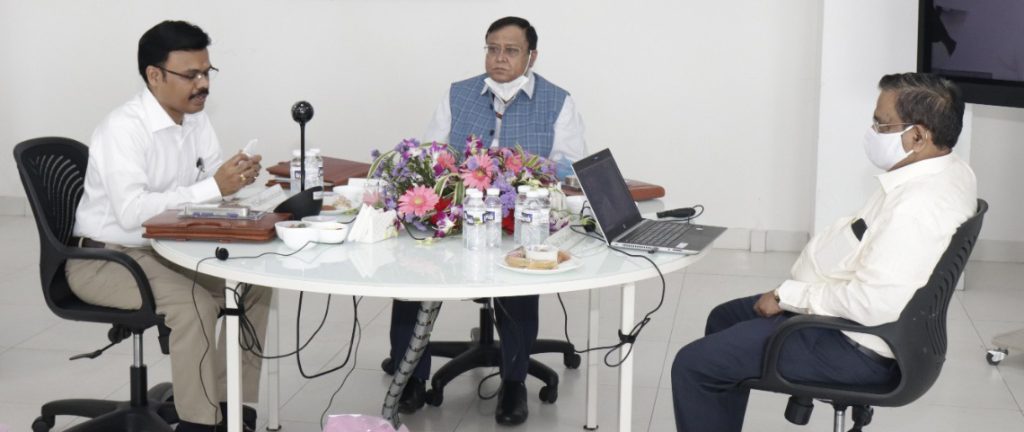 Prof D Narayana Rao, Pro-Vice-Chancellor, presented an overall roadmap of SRMAP’s progress in research so far and the way forward. The nascent university proudly houses 4500 students and 180 faculty with a few foreign nationals among them. Several DST- Inspire, DBT-Wellcome, Ramalingaswami and Ramanujan faculty are crowning the university with their exceptional research and teaching abilities. Stanford Research recognises the faculty of SRM University-AP among the world’s top 2% researchers. The university has published 678 papers in Scopus Indexed journals. The faculty are working on 38 projects with an outlay of 19.17 crores funded by the Government of India and Industry Giants.
Prof D Narayana Rao, Pro-Vice-Chancellor, presented an overall roadmap of SRMAP’s progress in research so far and the way forward. The nascent university proudly houses 4500 students and 180 faculty with a few foreign nationals among them. Several DST- Inspire, DBT-Wellcome, Ramalingaswami and Ramanujan faculty are crowning the university with their exceptional research and teaching abilities. Stanford Research recognises the faculty of SRM University-AP among the world’s top 2% researchers. The university has published 678 papers in Scopus Indexed journals. The faculty are working on 38 projects with an outlay of 19.17 crores funded by the Government of India and Industry Giants.
The committee agreed that fundamental areas cannot be compromised while working on the challenges in the education sector. Good students and faculty are to be attracted in order to pursue qualitative research. High end teaching and research facilities are essential for higher studies organisations. In initial years, collaborations can be beneficial for networking and promoting qualitative deliverables. The committee advocated for design schools to promote brainstorming for qualitative research. Every institution should have 4 fundamental pillars of education-teaching, research, industry-academia relation, societal benefits. Teaching and research should go hand-in-hand. The weakness of the institutions todays is undergrads are not given enough exposure to the practical knowledge of equipment. Critical thinking among students along with project-based teaching are to be encouraged from the initial years of the undergraduate studies.
Prof B S Murthy, Director, IIT-Hyderabad, Dr K Satyanarayana, Director, IIT-Tirupati, Dr S Chandra Sekhar, Director, CSIR-IICT, Hyderabad, Dr Mahendra Dev, Director & Vice Chancellor, Indira Gandhi Institute of Development Research, Mumbai, Prof M R Rao, Former Dean, Indian School of Business Hyderabad, Dr Tata Narasinga Rao, Director, International Advanced Research Centre for Powder Metallurgy & New Materials (ARCI), Hyderabad, Prof P Appa Rao, Former Vice Chancellor, University of Hyderabad, Dr K Varaprasada Reddy, Chairman Emeritus, Shantha Biotech Ltd Hyderabad, Dr S R Rao, Vice President, Sri Balaji Vidyapeeth Puducherry, Prof B P Sinha, ISI-Kolkata, Prof G P Das, Senior Professor, Indian Association for the Cultivation of Science, Kolkata, Prof R Balasubramanian, The Institute of Mathematical Sciences Taramani, Chennai, Prof U B Desai, Chancellor, Anurag University, Hyderabad, Prof B V R Chowdari, Nanyang Technological University Singapore, Prof Kamanio Chattopadhyay, IISc, Bangalore also participated in the meeting.
- Published in News, Research News
Design and implementation of frequency controller for wind energy-based hybrid power system
 Dr Tarkeshwar Mahto, Assistant Professor, in the Department of Electrical and Electronics Engineering has published a paper titled “Design and Implementation of Frequency Controller for Wind Energy-Based Hybrid Power System Using Quasi-Oppositional Harmonic Search Algorithm” in the reputed research journal, Energies.
Dr Tarkeshwar Mahto, Assistant Professor, in the Department of Electrical and Electronics Engineering has published a paper titled “Design and Implementation of Frequency Controller for Wind Energy-Based Hybrid Power System Using Quasi-Oppositional Harmonic Search Algorithm” in the reputed research journal, Energies.
An innovative union of fuzzy controller and proportional-integral-derivative (PID) controller under the environment of fractional order (FO) calculus is described in the present study for an isolated hybrid power system (IHPS) in the context of load frequency control. The proposed controller is designated as FO-fuzzy PID (FO-F-PID) controller. The undertaken model of IHPS presented here involves different independent power-producing units, a wind energy-based generator, a diesel engine-based generator and a device for energy storage (such as a superconducting magnetic energy storage system). The selection of the system and controller gains was achieved through a unique quasi-oppositional harmony search (QOHS) algorithm. The QOHS algorithm is based on the basic harmony search (HS) algorithm, in which the combined concept of quasi-opposition initialization and HS algorithm fastens the profile of convergence for the algorithm. The competency and potency of the intended FO-F-PID controller were verified by comparing its performance with three different controllers (integer-order (IO)-fuzzy-PID (IO-F-PID) controller, FO-PID and IO-PID controller) in terms of deviation in frequency and power under distinct perturbations in load demand conditions. The obtained simulation results validate the cutting-edge functioning of the projected FO-F-PID controller over the IO-F-PID, FO-PID and IO-PID controllers under non-linear and linear functioning conditions. In addition, the intended FO-F-PID controller, considered a hybrid model, proved to be more robust against the mismatches in loading and the non-linearity in the form of rate constraint under the deviation in frequency and power front.
The research group believes that the study will boost the use of renewable energy utilization for fulfilling energy requirements in a more reliable and stable manner. In future, they plan to use the knowledge gained from the isolated systems to develop a Multi-Migrigrid system.
Collaborations:
- Department of Electrical and Electronics Engineering, M S Ramaiah Institute of Technology, Bengaluru 560054, India
- The Berkeley Education Alliance for Research in Singapore, The National University of Singapore, Singapore 138602, Singapore
- Clean and Resilient Energy Systems (CARES) Lab, Texas A&M University, Galveston, TX 77553, USA;
- Department of Electrical Engineering, College of Engineering, Taif University, Taif 21944, Saudi Arabia
- Published in Departmental News, EEE NEWS, News, Research News
Dr Satheesh Ellipilli joins us as a Ramanujan Fellowship Faculty
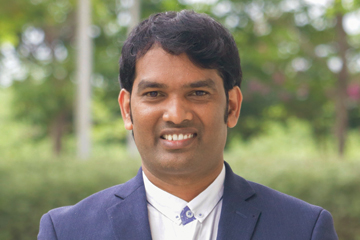 SRM University-AP is honoured to host Dr Satheesh Ellipilli as a DST- Ramanujan Fellowship Faculty and facilitate his research for the next five years.
SRM University-AP is honoured to host Dr Satheesh Ellipilli as a DST- Ramanujan Fellowship Faculty and facilitate his research for the next five years.
Ramanujan Fellowship is one of the most prestigious scientific fellowships that is offered to the Indian scientists working abroad. This fellowship is offered by Science and Engineering Research Board (SERB) to encourage scientists of Indian origin to return and research in an Indian institute/University.
SERB offers the scientists Rs 1,35,000/- per month along with research grant of Rs 7,00,000/- per annum and Rs 60,000/- per annum for overhead charges.
Dr. Satheesh Ellipilli obtained his PhD from Indian Institute of Science Education and Research, Pune. He worked as a postdoctoral researcher in The Ohio State University (Columbus, USA), Emory University (Atlanta, USA), and The University of Utah (Salt Lake City, USA).
Dr. Satheesh Ellipilli has extensive experience in the field of nucleic acid chemistry, particularly, focusing on utilization of RNA nanotechnology for cancer therapy using RNAi therapeutics in combination with small molecule drugs.
He has made numerous publications in some of the most renowned journals like Journal of Organic Chemistry, Journal of Controlled Release, Chemical Communications, Bioconjugate Chemistry, Organic and Biomolecular Chemistry, and Chemical Review to name a few.
Having Dr Ellipilli with us for the duration of his fellowship is a golden learning opportunity and a pleasure to be the host institution for his work. We hope that our students and scholars develop stronger research ethics and acumen in his company.
- Published in Chemistry-news, Departmental News, News
Assessment of corporate bodies in the light of corporate governance rating
![]() Assessing the grading and rating system in any corporation is important for the management and the stakeholders, and the more efficient they are the easier it becomes to plan future trajectories. SRM University-AP is happy to announce that Dr Lakshman Rao Ayyagari, Assistant Professor of Commerce has researched extensively on this issue and published a paper titled, “The ignored tool “corporate governance rating”: An overview of the corporate world in the emerging market” in “Journal of Governance and Regulation.
Assessing the grading and rating system in any corporation is important for the management and the stakeholders, and the more efficient they are the easier it becomes to plan future trajectories. SRM University-AP is happy to announce that Dr Lakshman Rao Ayyagari, Assistant Professor of Commerce has researched extensively on this issue and published a paper titled, “The ignored tool “corporate governance rating”: An overview of the corporate world in the emerging market” in “Journal of Governance and Regulation.
According to Dr Ayyagari, this research work is like a grading pattern, we adopt to rate and rank various organizations on various parameters, accordingly “Corporate Governance Rating” is a tool to assess firms’ performance, but not widely used in assessment, recommended for its use, keeping in mind the interests of various stakeholders.
About the research:
The interest of the Stakeholders is to see the growth of their entities, also they benchmark their entities through business performance metrics or tools like Return on Equity, Return on Assets, Earnings Per Share, Gross Profit Margin, Employee Productivity, Sales Turnover, ratings given by prominent credit rating agencies such as ICRA, CRISIL, Standard and Poor etc. In addition to this, internal governance mechanisms, board of directors’ characteristics, their independence, transparency, concentration, and presence of employees in the ownership structure also influence financial and stock market performance. However, assessing the performance of entities through some of these limited angles is not always possible. One more criterion for assessing the performance of entities is “Corporate Governance Rating”. However, it is not widely used as a tool to assess a firm’s performance in the emerging markets. The present research paper is intended to address the scenario of Corporate Governance Rating in the Corporate World to assess a firm’s performance. With the help of majorly secondary sources of data conducted a study from 2003 to 2021 based on the CRISIL’s rating pattern. The findings showed the significance of Corporate Governance Rating for its adoption and future research in the development of rating mechanisms in India as well as in emerging markets.
This research can be recommended to regulatory bodies especially in India like SEBI for conducting thorough research in this area for a policy study and implementation.
- Published in News, Research News


